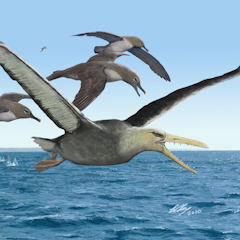
Articles on Pterosaurs
Displaying 1 - 20 of 28 articles

In 2021 a former avocado farmer discovered the most complete pterosaur skeleton ever found in Australia – and new research shows it represents a previously unknown species.

Understanding more about feathers could change the way we think about dinosaurs.

The Isle of Skye has a rich palaeontological heritage, so perhaps it’s no surprise scientists made an important discovery there.

Reptiles don’t generally care for their offspring, but some pterosaurs may have bucked the trend.

In the dinosaur era, flying reptiles soared in the skies of what is now Australia – but we have barely any fossil records of them.

Prehistoric reptiles like pterodactyls took flight long before bats and birds, but we don’t know how it happened.

We examined pterosaur jaw fragments from the Moroccan desert to understand more about how these creatures evolved.

Gigantic flying reptiles had impressive wingspans of up to 12 metres – and a special trick in their necks.

Did feathers evolve in the common ancestor of pterosaurs and dinosaurs? Not everyone is convinced

Tooth fossils from NSW have confirmed sauropods weren’t exclusive to Queensland. They’re also providing a first look at how these colossal dinosaurs fed from Australia’s land.

Fossils reveal that dinosaurs’ flying cousins become twice as efficient at flying over 150 million years.

Paleontologists have discovered fossil remains belonging to an enormous ‘toothed’ bird that lived for a period of about 60 million years after dinosaurs.

Today’s birds evolved from feathered dinosaurs.

Our new research has discovered how a series of volcanic eruptions 233 million years ago fundamentally changed life on Earth.

When the dinosaurs went extinct, some species took over the world. Adaptability, not survivability, explains why.

We found footprints that measure around 24 centimetres long. We suspect they came from animals with legs the same height as humans.

A ‘game-changing’ fossil pterosaur suggests these species could easily fly between continents, helping to explain why similar specimens have been found all over the world.

Dinosaurs ruled the Earth for about 180 million years. But around 66 million years ago, a huge rock from outer space (called an asteroid) smashed into the Earth. Then things got worse for dinosaurs.

A new type of Archaeopteryx fossil helps build the case for this creature being called ‘the first bird’.

Researchers use CT scanners to take first look inside pterosaur eggs.





